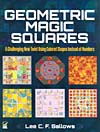- About MAA
- Membership
- MAA Publications
- Periodicals
- Blogs
- MAA Book Series
- MAA Press (an imprint of the AMS)
- MAA Notes
- MAA Reviews
- Mathematical Communication
- Information for Libraries
- Author Resources
- Advertise with MAA
- Meetings
- Competitions
- Programs
- Communities
- MAA Sections
- SIGMAA
- MAA Connect
- Students
- MAA Awards
- Awards Booklets
- Writing Awards
- Teaching Awards
- Service Awards
- Research Awards
- Lecture Awards
- Putnam Competition Individual and Team Winners
- D. E. Shaw Group AMC 8 Awards & Certificates
- Maryam Mirzakhani AMC 10 A Awards & Certificates
- Two Sigma AMC 10 B Awards & Certificates
- Jane Street AMC 12 A Awards & Certificates
- Akamai AMC 12 B Awards & Certificates
- High School Teachers
- News
You are here
Geometric Magic Squares

Publisher:
Dover Publications
Publication Date:
2013
Number of Pages:
135
Format:
Paperback
Price:
19.95
ISBN:
9780486489094
Category:
General
[Reviewed by , on ]
Charles Ashbacher
09/24/2013
The magic square, where an n x n grid is constructed with numbers in each cell that add to the same number across, up and down and diagonally, has long been a staple of recreational mathematics. The Lo Shu, a 3x3 magic square, originated in ancient China over 2,000 years ago and may be where the word “magic” was first associated with the squares. With this book, the field of magic squares is dramatically expanded.
Sallows uses geometric figures placed inside a grid so that the aggregation of the shapes forms the same structure as one moves across rows, down columns or diagonally. In some cases, the shapes across are not the sames as the shapes down, although all across are the same and all down are also the same. It is basically a repeated dissection problem.
The mathematics is elementary, basically simple addition of variables with cancellation. For example, in one construction, Sallows starts with squares and then defines a small set of attached structures, each of which is represented by a letter. If the structure protrudes, then it is assigned a plus and if it is recessed it is assigned a minus. Therefore, when a protrusion matches a recession, the two cancel out. If the base square is also assigned a letter and the auxiliary structures cancel, then the sum across or down is simply three squares. Using this representation, it is not difficult to apply the basic formula for the structure of a 3 x 3 magic square to create a geometric one that resembles a jigsaw puzzle.
Sallows uses many different shapes with colors to create a large number of geometric magic squares. Given the ease of understanding what is going on, even early elementary children can understand the positive/negative cancellation of of protruding/recessed shapes. This is a book that could be used by teachers at all levels of education as a resource for learning mathematics while having fun. It also introduces a new area of recreational mathematics.
Charles Ashbacher splits his time between consulting with industry in projects involving math and computers, teaching college classes and co-editing The Journal of Recreational Mathematics. In his spare time, he reads about these things and helps his daughter in her lawn care business.
| Foreword | |||||||
| I Geometric Squares of 3x3 | |||||||
| 1. Introduction | |||||||
| 2. Geomagic Squares | |||||||
| 3. The Five Types of 3x3 Area Square | |||||||
| 4. Construction by Formula | |||||||
| 5. Construction by Computer | |||||||
| 6. 3x3 Squares | |||||||
| 7. 3x3 Nasiks and Semi-Nasils | |||||||
| 8. Special Examples of 3x3 Squares | |||||||
| II Geometric Magic Squares of 4x4 | |||||||
| 9. Geo-latin Squares | |||||||
| 10. 4x4 Nasiks | |||||||
| 11. Graeco-latin Templates | |||||||
| 12. Uniform Square Substrates | |||||||
| 13. Dudeney's 12 Graphic Types | |||||||
| 14. The 12 Formulae | |||||||
| 15. A Type 1 Geomagic Square | |||||||
| 16. Self-interlocking Geomagics | |||||||
| 17. Form and Emptiness | |||||||
| 18. Further Variations | |||||||
| III Special Categories | |||||||
| 19. 2x2 Squares | |||||||
| 20. Picture-Preserving Geomagics | |||||||
| 21. 3-Dimensional Geomagics | |||||||
| 22. Alpha-Geomagic Squares | |||||||
| 23. Normal Squares of Order-4 | |||||||
| 24. Eccentric Squares | |||||||
| 25. Collinear Collations | |||||||
| 26. Concluding Remarks | |||||||
| Appendix 1. Formal Definition of Geomagic Squares | |||||||
| Appendix 2. Magic Formulae | |||||||
| Appendix 3. New Advances with 4x4 Magic Squares | |||||||
| Appendix 4. The Dual of Lo shu | |||||||
| Appendix 5. The Lost Theorem | |||||||
| Glossary | |||||||
| References |
- Log in to post comments




